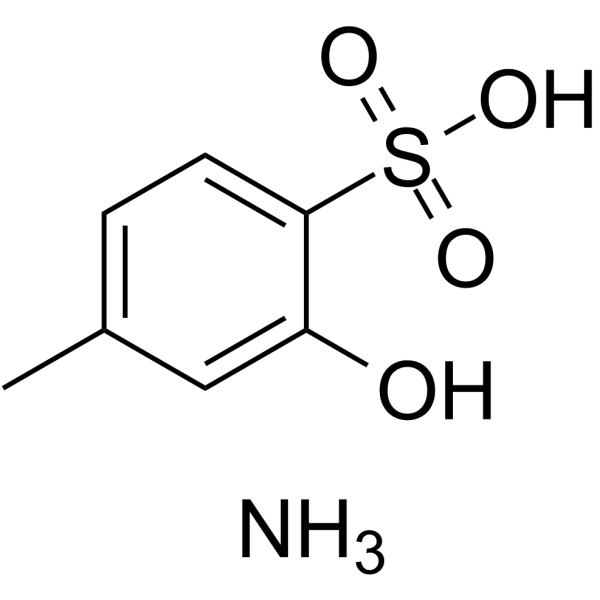Physicochemical Properties
| Molecular Formula | C7H11NO4S |
| Molecular Weight | 205.23 |
| Exact Mass | 205.041 |
| CAS # | 79093-71-3 |
| PubChem CID | 3018802 |
| Appearance | White to off-white solid powder |
| Boiling Point | 444.2ºC at 760 mmHg |
| Flash Point | 222.5ºC |
| LogP | 2.352 |
| Hydrogen Bond Donor Count | 2 |
| Hydrogen Bond Acceptor Count | 4 |
| Rotatable Bond Count | 0 |
| Heavy Atom Count | 13 |
| Complexity | 227 |
| Defined Atom Stereocenter Count | 0 |
| InChi Key | KGBVTRPJPQHXSU-UHFFFAOYSA-N |
| InChi Code | InChI=1S/C7H8O4S.H3N/c1-5-2-3-7(6(8)4-5)12(9,10)11;/h2-4,8H,1H3,(H,9,10,11);1H3 |
| Chemical Name | azanium;2-hydroxy-4-methylbenzenesulfonate |
| HS Tariff Code | 2934.99.9001 |
| Storage |
Powder-20°C 3 years 4°C 2 years In solvent -80°C 6 months -20°C 1 month Note: Please store this product in a sealed and protected environment, avoid exposure to moisture. |
| Shipping Condition | Room temperature (This product is stable at ambient temperature for a few days during ordinary shipping and time spent in Customs) |
Biological Activity
| References |
[1]. Policresulen, a novel NS2B/NS3 protease inhibitor, effectively inhibits the replication of DENV2 virus in BHK-21 cells. Acta Pharmacol Sin. 2015 Sep;36(9):1126-36. |
Solubility Data
| Solubility (In Vitro) | DMSO : 125 mg/mL (609.07 mM) |
| Solubility (In Vivo) |
Solubility in Formulation 1: ≥ 2.08 mg/mL (10.13 mM) (saturation unknown) in 10% DMSO + 40% PEG300 + 5% Tween80 + 45% Saline (add these co-solvents sequentially from left to right, and one by one), clear solution. For example, if 1 mL of working solution is to be prepared, you can add 100 μL of 20.8 mg/mL clear DMSO stock solution to 400 μL PEG300 and mix evenly; then add 50 μL Tween-80 to the above solution and mix evenly; then add 450 μL normal saline to adjust the volume to 1 mL. Preparation of saline: Dissolve 0.9 g of sodium chloride in 100 mL ddH₂ O to obtain a clear solution. Solubility in Formulation 2: ≥ 2.08 mg/mL (10.13 mM) (saturation unknown) in 10% DMSO + 90% (20% SBE-β-CD in Saline) (add these co-solvents sequentially from left to right, and one by one), clear solution. For example, if 1 mL of working solution is to be prepared, you can add 100 μL of 20.8 mg/mL clear DMSO stock solution to 900 μL of 20% SBE-β-CD physiological saline solution and mix evenly. Preparation of 20% SBE-β-CD in Saline (4°C,1 week): Dissolve 2 g SBE-β-CD in 10 mL saline to obtain a clear solution. Solubility in Formulation 3: ≥ 2.08 mg/mL (10.13 mM) (saturation unknown) in 10% DMSO + 90% Corn Oil (add these co-solvents sequentially from left to right, and one by one), clear solution. For example, if 1 mL of working solution is to be prepared, you can add 100 μL of 20.8 mg/mL clear DMSO stock solution to 900 μL of corn oil and mix evenly. (Please use freshly prepared in vivo formulations for optimal results.) |
| Preparing Stock Solutions | 1 mg | 5 mg | 10 mg | |
| 1 mM | 4.8726 mL | 24.3629 mL | 48.7258 mL | |
| 5 mM | 0.9745 mL | 4.8726 mL | 9.7452 mL | |
| 10 mM | 0.4873 mL | 2.4363 mL | 4.8726 mL |
